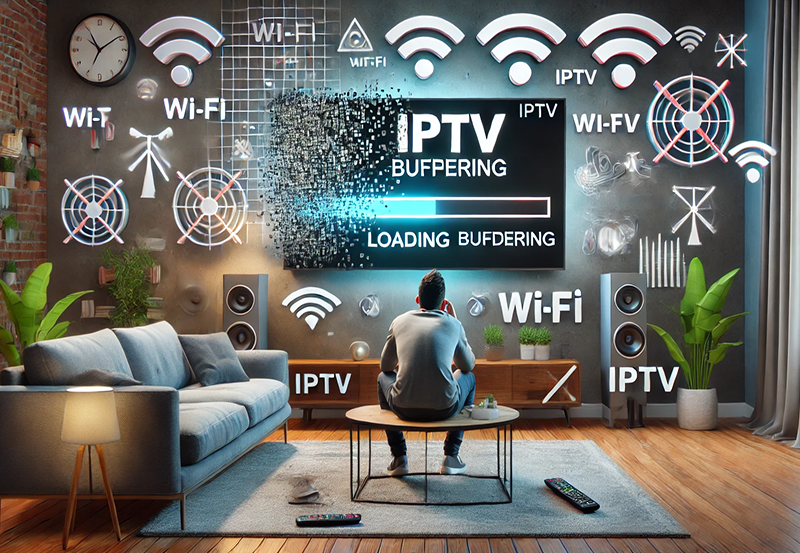Exploring IPTV’s intricate world might seem daunting initially, but finding ways to enhance its performance can make a huge difference in viewer experience. This guide is designed for those with a keen interest in technology and streaming services, eager to tackle IPTV latency from both a professional and end-user perspective. We’ll dive into actionable strategies and cutting-edge solutions to ensure you Amplify Your IPTV Enjoyment Effortlessly.
Buy 1 Year IPTV Subscription and Enjoy Unlimited Content
Understanding IPTV and Latency Challenges
IPTV, or Internet Protocol Television, is a service that allows you to stream television content using the internet instead of the traditional terrestrial, satellite signal, or cable formats. It has been gaining immense popularity due to its ability to provide flexible viewing experiences, particularly in accessing a range of channels globally.
However, a common drawback to IPTV is latency. Simply put, latency refers to the delay before a transfer of data begins following an instruction for its transfer. This delay can cause buffering and interrupted streams, leaving viewers frustrated. Recognizing the telltale signs of latency—and understanding how to minimize them—is crucial for service providers and users alike.
Why Top IPTV Subscriptions Matter
Top IPTV subscriptions promise reliability and improved streaming quality, crucial for addressing latency issues. High-quality providers usually offer better bandwidth, lower congestion, and servers strategically located to reduce latency. When selecting subscription packages, consider your content needs and geographic location.
Service quality often correlates with the price, where more premium packages can provide higher grade content streaming. Users must weigh these features against their budget to ensure a satisfactory balance between cost and service quality.
Factors Influencing Latency in IPTV
To tackle latency effectively, it’s essential to understand its root causes. Several aspects can influence this, such as network congestion, server response times, or even the quality of the equipment used on the user’s end.
- Bandwidth Limitations: Limited bandwidth can cause significant buffering and streaming disruptions.
- Hardware Constraints: Older model routers or set-top boxes sometimes struggle to handle high-speed streaming.
- Network Traffic: High traffic loads, especially during peak times, can choke the flow of data, increasing latency.
Effective Strategies to Mitigate IPTV Latency
Several practical strategies can minimize latency, tailored to both technical experts and end-users. Implementing these can vastly improve IPTV client satisfaction and broaden the appeal of IPTV services overall.
Optimizing Network and Bandwidth
Upgrading your internet connection remains one of the most straightforward methods to enhance IPTV performance. Consider subscribing to higher-speed plans that encompass adequate upload and download bandwidths.
Moreover, ensure your router is up-to-date. Ensure it supports dual-band frequencies to allocate network resources more efficiently. Such steps can economically tackle performance issues and bolster streaming quality.
Router Configuration for Enhanced Performance
Configuring your router optimally plays a pivotal role in reducing IPTV latency. This involves ensuring the latest firmware updates are applied and setting up Quality of Service (QoS) settings to prioritize video traffic over other types.
If technical skills permit, utilizing virtual private networks (VPNs) can reroute internet traffic, helping to avoid congested servers and decrease latency significantly.
Utilizing Advanced Technologies
As innovations continue, leveraging advanced technologies can further streamline IPTV operations. This includes incorporating Content Delivery Networks (CDNs) and exploring emerging solutions like edge computing.
Integrating CDN for Seamless Streaming
CDNs operate by distributing content closer to the end-user, mitigating latency by ensuring faster data retrieval times. Choosing a provider that effectively uses CDNs is pivotal in delivering content with minimal delay.
This, combined with optimized network configurations, can unnoticeably elevate the viewer’s experience, making it feel almost real-time, void of annoying buffering pauses.
Edge Computing and its Benefits
Edge computing involves processing data near the source rather than relying on centralized data centers, reducing latency by minimizing the distance data must travel. Adopting such systems might be resource-intensive initially, but the long-term benefits in reducing latency are invaluable.
These innovations represent the future, offering solutions that not only resolve latency concerns but also considerably enhance overall service delivery.
Exploring Best IPTV Options for Movies
Lovers of film and television often face latency issues, disrupting their viewing pleasure. Selecting the Best IPTV for streaming movies ensures a high-quality viewing experience, void of interruptions.
Curating a Movie-Ready IPTV Setup
To achieve seamless movie streaming, ensure that your Home P2P connections are optimized for movie content. This can be done by ensuring compatibility with high-definition streaming standards, reducing the likelihood of latency-related buffering.
Another tip is to create a dedicated slot during non-peak hours, ensuring your network is not competing for bandwidth with other connections in your vicinity. This simple yet effective change can dramatically reduce latency during crucial movie segments.
Making the Most of IPTV Subscriptions
Maximize your chosen subscription features by exploring those offering exclusive content and on-demand viewing options. This not only provides varied content but also ensures your chosen service invests in advanced streaming technologies that minimize latency.
Choose options that guarantee smoother transitions, higher resolutions, and reduced packet loss to ensure a viewing experience as seamless as it is engaging.
Maintenance and Troubleshooting Tips
Sustaining optimal IPTV performance requires regular system maintenance and proactive troubleshooting approaches to keep latency at bay. Here are best practices to follow consistently.
Proactive Troubleshooting Methods
Having troubleshooting strategies ready can quickly resolve potential disruptions. For instance, identify network issues by monitoring latency spikes, which will help isolate whether issues arise locally or from service provider channels.
Implementing simple solutions like restarting your router, updating firmware, or switching cables can often resolve disruptions without needing overhauls.
Maintenance Routines for Equipment
Regular checks on routers, modems, and other network equipment ensure they’re functioning optimally. Dusting, firmware updates, and periodic replacements as technology outpaces existing tools are all precursors to managing latency effectively.
Developing a habit of rebooting equipment regularly might also mitigate minor glitches that could escalate into greater latency issues.
A Future Perspective on IPTV
Moving forward, the IPTV landscape will likely see further innovations that bolster user experiences extensively. This evolution promises highly personalized, buffer-free content delivery, even as the demand for high-quality streaming intensifies.
Understanding current IPTV latency solutions provides invaluable insights for future advancements, laying a foundation for progress that meets viewer expectations consistently.
FAQ

How can I select the Top IPTV subscriptions efficiently?
Consider factors like content variety, geographic coverage, server locations, and customer reviews when selecting Top IPTV subscriptions readily available. Balance these elements with your specific streaming needs and budget.
What technology directly impacts IPTV latency the most?
Bandwidth quality and CDN integration heavily influence latency, as do router configurations trained to prioritize streaming traffic. Additionally, edge computing is rapidly becoming a frontrunner in providing low-latency solutions.
Can upgrading my internet plan eliminate IPTV latency entirely?
While upgrading to a faster internet plan can significantly reduce latency occurrences, it may not eliminate them entirely. Other factors like hardware quality and network configuration also impact performance.
Is VPN a viable solution for reducing IPTV latency?
Yes, a VPN can help reroute traffic through less congested servers, potentially decreasing latency. However, its effectiveness varies based on server locations and configurations.
Which IPTV service offers the Best IPTV for streaming movies?
There’s no one-size-fits-all answer, as user preferences and geographic factors heavily influence this. Look for services with optimized bandwidth, high server reliability, and good customer support to ensure a movie-friendly environment.
Are there any consistent maintenance steps to improve IPTV latency?
Yes, regular equipment checks, network monitoring, and updating software/firmware are essential maintenance routines that help manage and improve IPTV latency issues.
What future advancements might further reduce IPTV latency?
Emerging technologies, like edge computing and enhanced CDN strategies, continue to evolve, promising lower latency and enhancing overall streaming quality over time.
Enhancing Your IPTV Experience on Android Boxes with Perfect Player





